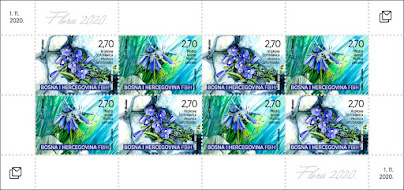Dobrodošli u svijet filatelije! Nadam se kako ćete postati redoviti posjetitelji ovoga bloga! Ako želite saznati što je to, ustvari, filatelija, ali i brojne druge zanimljivosti, možda pronađete nešto za sebe. Bit će vam dostupni svi prikupljeni materijali koji će mnogima i pomoći u ovome hobiju. Vjerujem i kako će raznovrsna ponuda i sami blog zainteresirati i one posjetitelje koji još nisu filatelisti te im pomoći u opredjeljenju za novi hobi.
28 studenoga, 2020
06 studenoga, 2020
HP Mostar - Flora 2020. Modro lasinje & Vriskova čestoslavica
Endemske biljke imaju malo područje rasprostranjenja i potrebno ih je poznavati kako bismo ih sačuvali i zaštitili, jer je svaka vrsta važna karika u ekosustavu. Motivi na markama HP Mostar u izdanju „Flora 2020“ dvije su endemske biljke.
Veronica saturejoides (Vriskova čestoslavica) je endemska biljka Bosne i Hercegovine. Ova višegodišnja puzava biljka naraste u dužinu od 10 do 30 cm. Korijeni su joj vlaknasti i drvenasti, a stabljike su na dnu pahuljaste i drvenaste. Listovi su jednostavni, blago nazubljeni, a na dnu sjedinjeni u obliku rozete. Cvjetovi hermafrodita imaju azurno plavu krunu i cvjetaju od svibnja do srpnja.
Moltkia petraea (Modro lasinje) također pripada grupi endemskih biljaka iz Bosne i Hercegovine. Ljubičastoplavi cvjetovi u obliku zvona hermafroditi su i skupljeni u gustim cvjetovima. Listovi su tamnozeleni, uski i duguljasti. Stabljika je prekrivena dlačicama i naraste do 50 cm visine. Ova listopadna trajnica cvjeta od svibnja do srpnja.
Hrvatska pošta Mostar izdala je 2 prigodne marke u listu od 8 maraka, poštanski žig i omot za prvi dan (FDC).
Endemic plants have a small area of distribution and it is necessary to know them in order to preserve and protect them, since each species is an important link in the ecosystem. The motifs on the HP Mostar stamps in the „Flora 2020” edition are two endemic plants.
Veronica saturejoides (Vriskova čestoslavica) is an endemic plant of Bosnia and Herzegovina. This perennial creeping plant grows to a length of 10 to 30 cm. Its roots are fibrous and woody, and the stems are fluffy and woody at the bottom. The leaves are simple, slightly serrated, and at the bottom united in the shape of a rosette. The hermaphrodite flowers have an azure blue crown and bloom from May to July.
Moltkia petraea (Modro lasinje) also belongs to the group of endemic plants from Bosnia and Herzegovina. The purple-blue bell-shaped flowers are hermaphrodite and clustered in dense blossoms. The leaves are dark green, narrow and oblong. The stem is covered with hairs and grows up to 50 cm in height. This deciduous perennial blooms from May to July.
Croatian Post Mostar has issued 2 commemorative stamps in a sheet of 8 stamps, a postmark and a first day cover (FDC).
Izvor (source) HP Mostar
HP Mostar - Fauna 2020. Leptiri - Butterflies
Prvi razvojni oblik leptira je jaje u kojemu se razvija mlada ličinka (gusjenica) koja se, prije nego što se zakukulji, pričvrsti na zaštićenu mjestu. Kada se leptir izvuče iz kukuljice, raširi krila da se osuše i već je spreman za let.
Hrvatska pošta Mostar predstavlja četiri vrste dnevnih leptira koji obitavaju na području BiH. Brodar sa žutim prugama (Pyrgus sidae Esper) potvrđen je na više lokaliteta i smatra se uobičajenom vrstom u Hercegovini. Dalmatinski okaš (Proterebia afra dalmata) pronađen je na lokalitetu Dobrići kod Buškog jezera. Panonska preljevalica (Apatura metis Freyer) zabilježena je u sjevernoj Bosni kod Srbca. Asmanova riđa (Melitaea britomartis Assmann) prvi put je zabilježena na lokalitetu Vještić Gora.
Danji leptiri spadaju u najljepše životinjske skupine, ali su danas ugroženi djelovanjem čovjeka. Livade su najugroženija staništa, njihovim nestankom i nestankom tradicionalnog stočarstva nestaje i fauna koja je tu živjela.
Hrvatska pošta Mostar izdala je 4 prigodne poštanske marke u arku od 8 maraka, žig i omotnicu prvoga dana (FDC).
The first form of development of a butterfly is the egg, in which the young larva (caterpillar) develops, which settles in a sheltered place before pupating. After the butterfly pulls out of the pupa, it spreads its wings to dry and is ready to fly.
The Croatian Post Mostar presents four species of diurnal butterflies that live on the territory of Bosnia and Herzegovina. The Yellow-banded skipper (Pyrgus sidae Esper) has been confirmed in several localities and is a common species in Herzegovina. The Dalmatian argus (Proterebia afra dalmata) was found in the Dobrići locality near the Buško jezero lake. Freyer`s Purple Emperor (Apatura metis Freyer) was discovered in northern Bosnia near Srbac. Assmann's fritillary (Melitaea britomartis Assmann) was first recorded at the locality Vještić Gora.
Diurnal butterflies are one of the most beautiful animal groups, but are now endangered due to human activities. Meadows are the most endangered habitats. With their disappearance and the disappearance of traditional livestock farming, the fauna that lived there also disappears.
Croatian Post Mostar has issued 4 commemorative stamps in a sheet of 8 stamps, a postmark and a first day cover (FDC).
Izvor (source) HP Mostar


